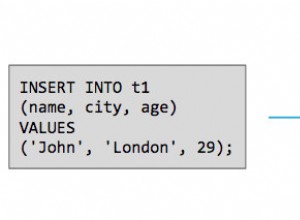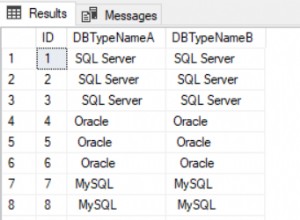De acordo com a documentação ,
Portanto, removendo o
not null -restrição de Status e adicionando um índice exclusivo em (ContactId,PhoneId,Status) funcionará como você deseja, se você usar null em vez de 0 para inativo registros. Se você não quiser ou não puder usar
null para seu Status coluna, queremos ter certeza de que Status=0 e Status=null comportam-se de forma idêntica, ou e. deseja tratar Status=2 como ativo (e impondo exclusividade) também, você pode adicionar uma coluna fictícia que será calculada a partir de Status . Se você estiver usando o MySQL 5.7+, você pode fazer isso com uma coluna gerada:
CREATE TABLE IF NOT EXISTS `ContactPhone` (
`ContactPhoneId` int(10) unsigned NOT NULL auto_increment primary key,
`ContactId` int(11) NOT NULL,
`PhoneId` smallint(5) unsigned NOT NULL,
`Status` tinyint(1) NOT NULL DEFAULT '1',
`StatusUnq` tinyint(1) as (if(Status <> 0, 1, null)) stored null,
constraint unique (ContactId, PhoneId, StatusUnq)
) ENGINE=MyISAM AUTO_INCREMENT=1 DEFAULT CHARSET=latin1;
insert into ContactPhone (ContactPhoneId, ContactId, PhoneId, Status)
values (1, 1, 1, 1);
insert into ContactPhone (ContactPhoneId, ContactId, PhoneId, Status)
values (2, 1, 1, 1);
-- Duplicate key error
insert into ContactPhone (ContactPhoneId, ContactId, PhoneId, Status)
values (3, 1, 1, 0);
insert into ContactPhone (ContactPhoneId, ContactId, PhoneId, Status)
values (4, 1, 1, 0);
update ContactPhone set Status = 1 where ContactPhoneId = 4;
-- Duplicate key error
Caso contrário, você pode usar uma coluna normal e usar gatilhos para calcular o valor da coluna, por exemplo:
create trigger trbi_contactPhoneUnique before insert on ContactPhone
for each row
set new.StatusUnq = if(new.Status <> 0, 1, null);
create trigger trbu_contactPhoneUnique before update on ContactPhone
for each row
set new.StatusUnq = if(new.Status <> 0, 1, null);
É claro que você pode mudar a fórmula para, por exemplo,
if(new.Status <> 0, new.Status, null); se você quiser permitir valores diferentes de Status também. 



